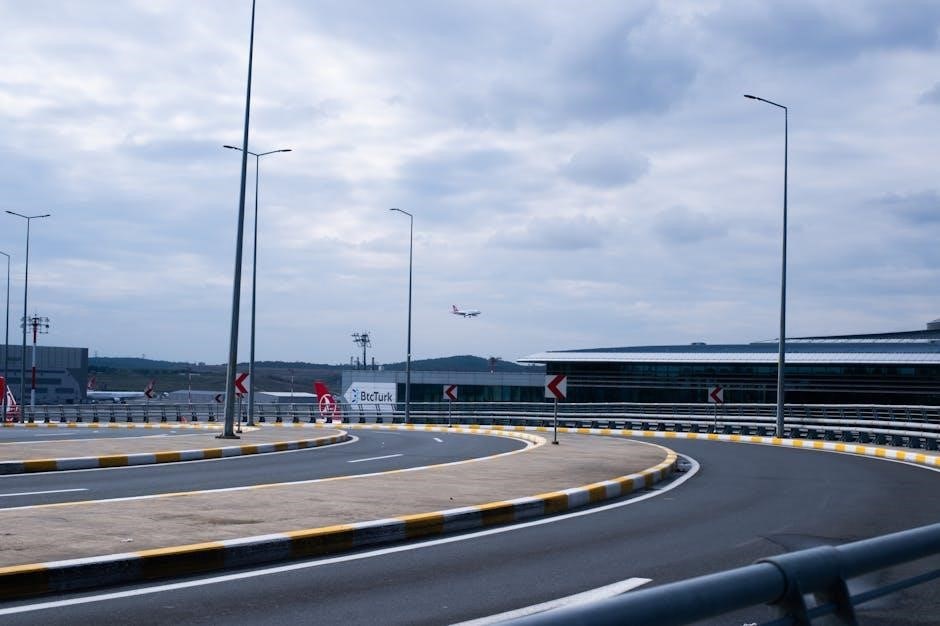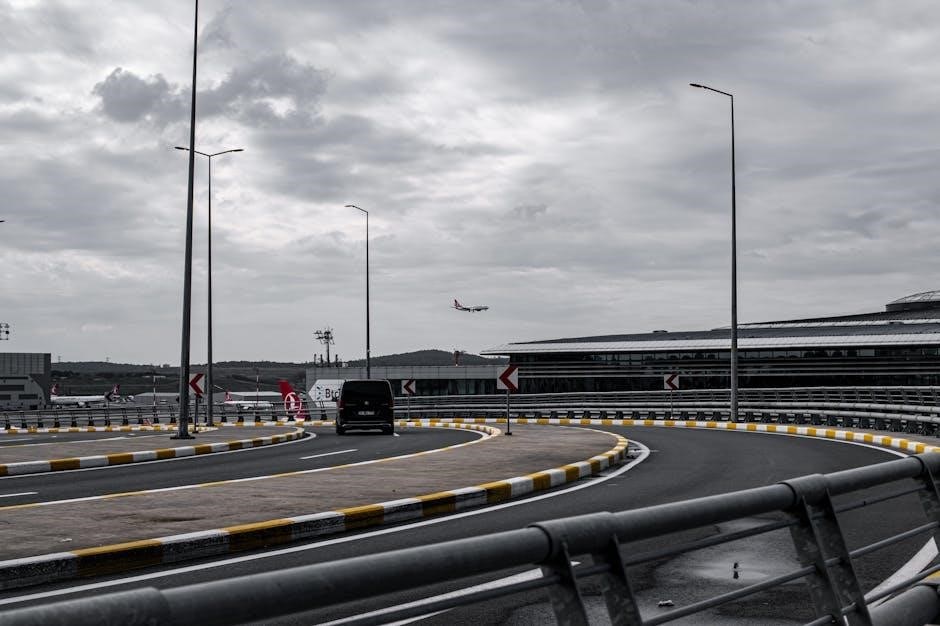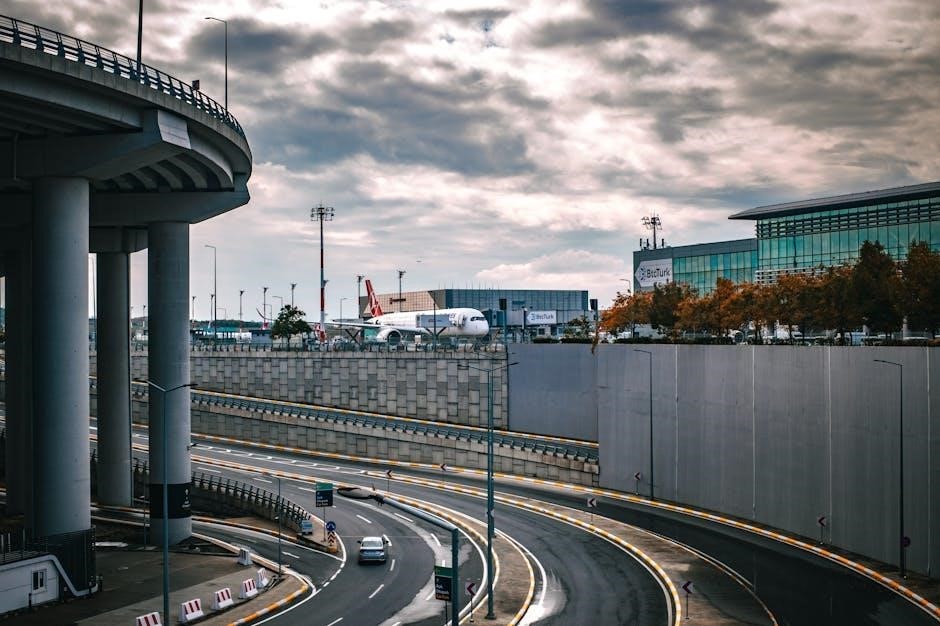Aviation is the art and science of designing, manufacturing, and operating aircraft, transforming global connectivity and commerce․ Recent advancements, like Volato’s private aviation expansion and tax provision updates, highlight its evolution and innovation․
History of Aviation
The history of aviation began with early experiments in flight, culminating in the Wright Brothers’ successful powered flight in 1903․ This milestone marked the birth of modern aviation, leading to rapid advancements in aircraft design and technology․ The interwar period saw the rise of commercial airlines, while World War II drove innovation in military aviation․ The post-war era introduced jet engines, revolutionizing air travel․ Today, aviation is a global industry, connecting millions worldwide, with continuous advancements shaping its future․
Types of Aircraft
Aircraft are categorized into commercial, private, and military types․ Commercial aircraft include airliners and regional jets, designed for mass passenger transport․ Private aviation features business jets and helicopters, offering luxury and flexibility․ Military aircraft range from fighter jets to transport planes, serving defense and logistics․ Recent innovations, like Volato’s private aviation expansion, highlight the diversity and evolution of aircraft types, catering to various needs and industries․ Each category plays a vital role in shaping global connectivity and economic activities․
The Aviation Industry
The aviation industry encompasses commercial, private, and military sectors, driving global connectivity and economic growth․ Recent tax provisions and infrastructure upgrades, like new boarding bridges, enhance its efficiency․
Commercial Aviation
Commercial aviation is a cornerstone of global transportation, connecting millions daily via passenger and cargo services․ Recent developments, such as Volato’s expansion and tax provision updates, highlight its growth․ Airlines optimize efficiency through advanced technologies and sustainable practices, ensuring safer and greener operations․ The sector’s resilience amid challenges underscores its vital role in the economy and international connectivity․

Private Aviation
Private aviation offers exclusive travel solutions, catering to individuals and businesses seeking convenience and luxury․ Platforms like Volato’s Vaunt are expanding, supported by favorable tax provisions such as 100% bonus depreciation․ This sector emphasizes flexibility, privacy, and personalized service, making it a preferred choice for discerning travelers․ Recent enhancements in airport infrastructure, like new boarding bridges and virtual information desks, further elevate the private aviation experience, ensuring efficiency and comfort for its users․
Military Aviation
Military aviation plays a critical role in national defense, surveillance, and strategic operations․ Advanced technologies, including unmanned aerial vehicles (UAVs) and enhanced navigation systems, are transforming military capabilities․ Partnerships with research institutions, like the University of Kentucky’s Center for Applied Energy Research, drive innovation in aviation technology․ These advancements ensure military aircraft remain at the forefront of global security efforts, supporting missions and maintaining stability worldwide․
Airport Infrastructure
Airport infrastructure includes terminals, runways, and ground handling systems․ Recent upgrades, such as new Passenger Boarding Bridges and Virtual Information Desks, enhance efficiency and passenger experience․
Air Traffic Control Systems
Air Traffic Control (ATC) systems are critical for managing aircraft movements, ensuring safety, and optimizing flight paths․ Advanced technologies like radar, ADS-B, and automated systems enhance efficiency and reduce delays․ These systems coordinate takeoffs, landings, and en-route operations, maintaining separation between aircraft․ Modernization efforts focus on integrating AI and real-time data to handle increasing air traffic․ Effective ATC systems are essential for preventing collisions and streamlining global air travel, making them a cornerstone of aviation infrastructure․
Airport Terminals and Facilities
Airport terminals and facilities are essential for efficient passenger and cargo operations․ Modern terminals feature advanced technologies like Virtual Information Desks and clear wayfinding signage to enhance passenger experience․ Recent upgrades include the addition of six new Passenger Boarding Bridges (PBBs), improving boarding and deboarding efficiency․ These facilities also integrate sustainability measures and innovative designs to accommodate growing demand․ Effective terminal management ensures seamless operations, making airports hubs of connectivity and comfort for travelers worldwide․
Ground Handling and Operations
Ground handling and operations are critical for ensuring efficient aircraft and passenger services; This includes fueling, baggage handling, and maintenance․ Recent advancements focus on sustainability, with initiatives like the collaboration between the University of Kentucky’s Center for Applied Energy Research (UK CAER) and the Kentucky Energy and Environment Cabinet (EEC) driving eco-friendly practices․ These efforts aim to reduce environmental impact while maintaining operational efficiency and safety standards․ Effective ground handling is essential for seamless aviation operations and passenger satisfaction․
Aviation Technology
Aviation technology encompasses innovations transforming the industry, enhancing efficiency, safety, and sustainability; Recent advancements include improved ground handling systems and eco-friendly practices, driving the future of flight․
Advances in Aircraft Design
Recent advancements in aircraft design focus on efficiency, sustainability, and performance․ Innovations include lightweight materials, aerodynamic improvements, and hybrid-electric propulsion systems․ These developments reduce fuel consumption and emissions, aligning with global sustainability goals․
Additionally, the integration of advanced avionics and AI-driven systems enhances safety and operational capabilities․ Such innovations are supported by initiatives like tax provisions for private aviation, fostering investment in cutting-edge technologies and future-proof designs․

Navigation and Communication Systems
Modern navigation and communication systems in aviation rely on advanced technologies to ensure safe and efficient operations․ Satellite-based navigation systems provide precise location data, while next-generation communication tools enable real-time data exchange between aircraft and air traffic control․
These systems are complemented by innovations like Virtual Information Desks and enhanced wayfinding signage, improving operational efficiency․ Such advancements are crucial for maintaining safety standards and supporting the growing demands of the aviation industry․
Airport Technology Innovations

Airport technology innovations are transforming the passenger experience and operational efficiency․ Recent advancements include the installation of six new Passenger Boarding Bridges (PBBs), which accelerate boarding and deboarding processes․ Additionally, Virtual Information Desks and enhanced wayfinding signage have been introduced to improve navigation and accessibility for travelers․
These innovations not only streamline airport operations but also enhance passenger convenience․ Such technological upgrades are essential for meeting the growing demands of modern air travel, ensuring a seamless and efficient experience for all users․

Sustainability in Aviation
Aviation is prioritizing sustainability through electric and hybrid aircraft development, carbon offset programs, and fuel efficiency improvements, reducing environmental impact while advancing innovative solutions for greener skies․
Fuel Efficiency and Emissions Reduction
Aviation is advancing fuel efficiency through engine innovations and sustainable aviation fuels (SAF), reducing greenhouse gas emissions․ Recent tax provisions and carbon offset programs further support emissions reduction efforts, aligning with global sustainability goals․ These initiatives aim to minimize environmental impact while maintaining operational performance, ensuring a greener future for air travel․

Electric and Hybrid Aircraft
Electric and hybrid aircraft are revolutionizing aviation by reducing emissions and operating costs․ Companies like Eviation and Joby Aviation are pioneering electric planes, while hybrid-electric propulsion systems aim to enhance fuel efficiency․ These innovations are particularly promising for short-haul and regional flights, offering quieter operations and lower environmental impact․ Despite challenges in battery technology and infrastructure, electric and hybrid aircraft represent a significant step toward sustainable aviation, aligning with global efforts to reduce carbon footprints and promote eco-friendly transportation solutions․

Carbon Offset Programs
Carbon offset programs allow individuals and organizations to compensate for their carbon emissions by investing in projects that reduce greenhouse gases․ In aviation, these programs often fund renewable energy, reforestation, or energy efficiency initiatives․ For instance, the University of Kentucky’s Center for Applied Energy Research collaborates with the Kentucky Energy and Environment Cabinet to develop sustainable solutions․ By supporting such projects, aviation stakeholders can offset their environmental impact, promoting a greener future and aligning with global climate goals to reduce net emissions effectively․
Aviation Safety
Aviation safety encompasses rigorous protocols, advanced technologies, and continuous training to ensure secure flight operations and protect passengers, crew, and aircraft from potential hazards․
Safety Regulations and Standards
Safety regulations and standards are critical to ensuring the integrity of aviation operations․ These guidelines, set by global authorities, mandate strict compliance with maintenance, training, and operational protocols․ The University of Kentucky Center for Applied Energy Research and the Kentucky Energy and Environment Cabinet collaborate on initiatives to enhance safety and environmental standards․ These regulations ensure aircraft airworthiness, crew proficiency, and adherence to best practices, minimizing risks and safeguarding passengers and crew․ Continuous updates to these standards address emerging challenges and technological advancements in aviation․
Safety Management Systems (SMS)
Safety Management Systems (SMS) are structured frameworks that enable organizations to manage safety risks effectively․ They integrate safety policies, procedures, and processes to ensure proactive hazard identification and mitigation․ SMS implementations are mandated by regulatory bodies like ICAO and FAA, requiring airlines, airports, and maintenance organizations to adopt a systematic approach to safety․ By fostering a safety-first culture, SMS enhances operational reliability and minimizes risks, ensuring the well-being of passengers, crew, and assets․ Regular audits and continuous improvement are key to maintaining robust SMS performance․
Incident Reporting and Analysis
Incident reporting and analysis are critical for identifying safety risks and improving aviation practices․ Through detailed documentation and investigation, incidents are examined to determine root causes and preventive measures․ Advanced data analytics tools enable deeper insights, while standardized reporting protocols ensure consistency․ For instance, the University of Kentucky’s Center for Applied Energy Research collaborates with the Kentucky Energy and Environment Cabinet to analyze environmental incidents, showcasing how comprehensive analysis drives safety and operational improvements across the aviation sector․
Aviation Economics
Aviation economics encompasses the financial aspects of the industry, including aircraft financing, tax considerations, and insurance․ Recent tax provisions, like 100% bonus depreciation, impact private aviation investments significantly․
Aircraft Financing and Leasing
Aircraft financing and leasing are critical components of aviation economics, enabling individuals and businesses to acquire aircraft without upfront purchases․ Methods include secured loans, operating leases, and tax-driven structures․ Recent tax provisions, such as 100% bonus depreciation, have made private aviation investments more attractive․ Leasing options, like fractional ownership, allow shared access to aircraft, reducing costs․ These financial strategies are essential for managing the high capital requirements of aviation, ensuring accessibility and sustainability for both private and commercial operators․
Tax Considerations in Aviation
Tax considerations play a pivotal role in aviation, influencing ownership and operational costs․ Recent tax provisions, such as the reinstatement of 100% bonus depreciation, have significantly impacted private aviation․ These incentives allow businesses and individuals to deduct the full cost of aircraft purchases, reducing taxable income․ Additionally, accelerated depreciation schedules can lower financial burdens․ Understanding these tax strategies is essential for optimizing aviation investments, ensuring compliance, and maximizing financial benefits in both private and commercial aviation sectors․
Insurance in Aviation
Insurance in aviation is critical for mitigating risks associated with aircraft operations․ Policies typically cover hull damage, liability, and passenger risks․ Premiums vary based on aircraft type, usage, and operator history․ Liability insurance is mandatory to cover third-party damages, while hull insurance protects the aircraft itself․ Additional coverage options include war risk insurance and cargo insurance․ Insurers assess factors like pilot experience and maintenance records to determine premiums․ Proper insurance coverage is essential for safeguarding investments and ensuring compliance with aviation regulations․

Private Aviation
Private aviation offers personalized travel solutions, with services like fractional ownership and charter flights․ Recent tax provisions and innovations enhance accessibility and efficiency for private aircraft users․
Fractional Ownership Programs
Fractional ownership programs offer a cost-effective way to access private aviation benefits․ These programs allow multiple individuals or entities to share ownership of an aircraft, reducing costs while maintaining flexibility․ Participants typically purchase a fraction of the aircraft, granting them a set number of flight hours annually․ This model is particularly appealing for businesses and individuals who require frequent private travel but do not need full ownership․ With shared maintenance and operational expenses, fractional ownership provides an accessible entry into private aviation, combining luxury with practicality․
- Cost-sharing reduces individual financial burden․
- Access to a fleet of aircraft for diverse needs․
- Ideal for those seeking flexibility without full ownership․
Charter Services and Brokerage
Charter services and brokerage provide tailored private aviation solutions, offering on-demand access to aircraft for individuals and organizations․ Brokers act as intermediaries, connecting clients with suitable planes and negotiating optimal rates․ This flexible model allows travelers to choose from a wide range of aircraft, ensuring missions are customized to specific needs․ With no long-term commitments, charter services are ideal for occasional or variable travel demands, delivering convenience and efficiency without ownership responsibilities․
- On-demand access to various aircraft types․
- Brokers streamline the booking and logistics process․
- Cost-effective for irregular or unique travel needs․
Tax Provisions for Private Aviation
Understanding tax provisions is crucial for optimizing private aviation investments․ Recent updates, such as the reinstatement of 100% bonus depreciation, allow businesses and individuals to deduct the full cost of an aircraft in the first year․ This incentive makes private aviation more accessible and financially attractive․ Tax strategies, including depreciation and operational deductions, can significantly reduce the net cost of ownership; Staying informed about evolving tax laws ensures compliance and maximizes financial benefits for private aviation enthusiasts and operators․
- 100% bonus depreciation for aircraft purchases․
- Deductions for operational and maintenance costs․
- Tax strategies to reduce ownership expenses․

Future of Aviation
Aviation’s future is shaped by innovation, sustainability, and emerging technologies․ Advances in electric aircraft, space tourism, and unmanned systems promise exciting possibilities for global connectivity and exploration․
Unmanned Aerial Vehicles (UAVs)

Unmanned Aerial Vehicles (UAVs), or drones, are revolutionizing aviation by enabling autonomous operations․ They are increasingly used for surveillance, cargo delivery, and environmental monitoring․ Recent advancements in AI and navigation systems have enhanced their capabilities․ The University of Kentucky’s research and collaborations highlight their potential in energy and environmental applications․ As UAV technology matures, it promises to transform industries, improve efficiency, and open new possibilities for global connectivity and innovation․
Space Tourism and Commercial Spaceflight
Space tourism and commercial spaceflight are pioneering new frontiers in aviation, offering unprecedented access to space for civilians․ Companies like Virgin Galactic and Blue Origin are leading this revolution, providing suborbital flights and orbital experiences․ Private investment and technological advancements are driving this sector, with reusable rockets and spacecraft enabling cost-effective missions․ As space tourism grows, it opens opportunities for scientific research, education, and exploration․ However, challenges like safety, regulations, and environmental impact remain critical considerations for sustainable growth in this emerging field․
Emerging Technologies in Aviation
Emerging technologies are transforming aviation, enhancing efficiency and sustainability․ Electric and hybrid-electric propulsion systems are being developed to reduce emissions․ Advanced materials like lightweight composites improve fuel efficiency․ AI and machine learning optimize flight routes and predictive maintenance․ Autonomous systems, including UAVs, are expanding operational capabilities․ Virtual and augmented reality enhance pilot training and passenger experiences․ These innovations, supported by research institutions and private investments, are reshaping the future of aviation, ensuring it remains a cornerstone of global connectivity and economic growth․



